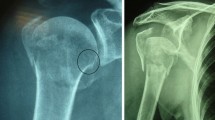Abstract
Objective
Anatomical reduction of two- to four-part fractures of the proximal humerus using indirect reduction techniques. Intramedullary fixation with a short humerus nail. Restoration of a stable bone-implant construct that enables early functional after-treatment.
Indications
Displaced and unstable two- to four-part fractures of the proximal humerus. Fractures of the proximal humerus extending in the humeral diaphysis (use a long nail). Ipsilateral combined lesions of the proximal humerus and the humeral diaphysis (use a long nail).
Contraindications
Poor physical and/or mental status. Critical soft tissue conditions in the area near the surgical site. Local soft tissue infection. Pre-existing severe osteoarthritis of the shoulder joint; severe shoulder stiffness. Head-split fractures of the humerus head that cannot be reduced.
Surgical technique
Exposure of the fracture using an anterior acromial approach and determination of the correct nail entrance point. Anatomic fracture reduction using indirect reduction techniques. Stable fixation using an intramedullary MultiLoc® nail. Determination of the proximal locking configuration depending on the fracture morphology. Distal locking with angle-stable option.
Post-operative treatment
Post-operative radiographs for documentation of the surgical result and implant position. Use of an arm sling for 7–10 days. Active and passive exercises of the shoulder joint starting on day 1. Shoulder abduction limited to 60° for 2 weeks. Subsequent abduction to 90° until the 4th week. Subsequent active mobilisation without restrictions. Weight bearing and sporting activities after 3 months. Radiological evaluation after 2, 6 and 12 weeks.
Results
During a 6-month period, 160 patients were documented in a prospective clinical multicentre study. According to the AO classification, there were 36% A-type fractures, 41% B- and 23% C-type injuries. A 6-month follow-up was available for 17 patients. The mean age of these patients was 67 years. One patient had an A-type fracture. There were ten B- and six C-type fractures. At the time of follow-up, the mean Constant score was 66 points. Radiographically, all fractures had healed. Intra-articular screw penetration and loss of reduction were both observed once.
Zusammenfassung
Operationsziel
Anatomiegerechte Reposition der 2- bis 4-Fragment Humeruskopffraktur unter Anwendung von indirekten Repositionstechniken. Fixation mit einem kurzen intramedullären Humerusnagel. Herstellen eines stabilen Knochen-Implantat-Verbunds, welcher eine frühfunktionelle Nachbehandlung ermöglicht.
Indikationen
Dislozierte und instabile 2-, 3- und 4-Fragment-Frakturen des Humeruskopfes. Proximale Humerusfrakturen, ausstrahlend in die Diaphyse (Verwendung eines langen Nagels). Ipsilaterale Kombinationsverletzungen von Humeruskopffrakturen und diaphysären Humerusschaftfrakturen (Verwendung eines langen Nagels).
Kontraindikationen
Schlechter physischer und/oder psychischer Allgemeinzustand. Lokal kritische Weichteilverhältnisse im Zugangsbereich. Lokale Weichteilinfektion. Vorbestehende fortgeschrittene Omarthrose und Einsteifung des Schultergelenks. Nicht rekonstruierbare Head-split-Frakturen des Humeruskopfes.
Operationstechnik
Darstellen der Fraktur über einen vorderen akromialen Zugang und Bestimmen der korrekten Nageleintrittstelle. Anatomiegerechte Frakturreposition unter Verwendung von indirekten Repositionstechniken. Stabile Fixation mit einem intramedullär eingebrachten MultiLoc® Humerusnagel. Wahl der proximalen Verriegelungskonfiguration in Abhängigkeit von der Frakturmorphologie. Distale Verriegelung mit winkelstabiler Option.
Weiterbehandlung
Postoperative Röntgenkontrolle zur Dokumentation der Reposition und Implantatlage. Benutzung einer Armschlinge für 7–10 Tage. Ab dem 1. postoperativen Tag passive und aktiv-assistive Bewegungsübungen des Schultergelenks bis 60° Abduktion für 2 Wochen. Danach Abduktion bis 90° bis Ende 4. Woche. Anschließend Freigabe der Beweglichkeit. Belastung und Sport nach 3 Monaten. Röntgenkontrollen nach 2, 6 und 12 Wochen.
Ergebnisse
In einem Zeitraum von 6 Monaten wurden in einer prospektiven multizentrischen Studie 160 Patienten prospektiv erfasst. Nach der AO-Klassifikation handelte es sich um 36% Typ-A-, 41% Typ-B- und 23% Typ-C-Verletzungen. Siebzehn Patienten konnten nach 6 Monaten untersucht werden. Durchschnittsalter der Patienten war 67 Jahre. Frakturmorphologisch fanden sich 1 Typ-A-, 10 Typ-B- und 6 Typ-C-Verletzungen. Der durchschnittliche Constant-Score lag bei 66 Punkten. Radiologisch waren alle Frakturen geheilt. Eine intraartikuläre Schraubenperforation und ein Repositionsverlust wurden in jeweils einem Fall beobachtet.















Similar content being viewed by others
References
Blum J, Rommens PM (2002) Proximale Verriegelung von Humerusmarknägeln und Verletzungsrisiko des N. axillaris. Unfallchirurg 105:9–13
Blum J, Hansen M, Rommens PM (2009) Die winkelstabile Marknagelung bei Frakturen am proximalen Humerus mit dem PHN. Oper Orthop Traumatol 21:296–311
Gardner MJ, Boraiah S, Helfet DL, Lorich DG (2008) The anterolateral acromial approach for fractures of the proximal humerus. J Orthop Trauma 22:132–137
Gierer P, Scholz M, Beck M et al (2010) Microcirculatory sequellae of the rotator cuff after antegrade nailing in proximal humeral fracture. Arch Orthop Trauma Surg 130:687–691
Hepp P, Lill H, Bail H et al (2003) Where should implants be anchored in the humeral head? Clin Orthop 415:139–147
Hessmann MH, Rommens PM (2001) Osteosynthesetechniken bei proximalen Humerusfrakturen. Chirurg 72:1235–1245
Hessmann MH, Sternstein W, Hansen M et al (2005) Locked plate fixation and intra-medullary nailing for proximal humeral fractures: a biomechanical evaluation. J Trauma 58:1194–1201
Horn J, Gueorguiev B, Brianza S et al (2011) Biomechanical evaluation of two-part surgical neck fractures of the humerus fixed by an angular stable locked intramedullary nail. J Orthop Trauma 25:406–413
Mathews J, Lobenhoffer P (2007) Marknagelung instabiler proximaler Humerusfrakturen. Oper Orthop Traumatol 19:255–275
Mittlmeier TW, Stedtfeld HW, Ewert A et al (2003) Stabilization of proximal humeral fractures with an angular and sliding stable antegrade locking nail. J Bone Joint Surg 85-A(Suppl 4):136–146
Noda M, Saegusa Y, Maeda T (2011) Does the location of the entry point affect the reduction of proximal humerus fractures? A cadaveric study. Injury 42(Suppl 4):35–38
Rothstock S, Plecko M, Kloub M et al (n d) Biomechanical evaluation of two intramedullary nailing techniques with different locking options in a three-part fracture proximal humerus model. Clin Biomech, in press
Young AA, Hughes JS (2008) Locked intramedullary nailing for treatment of displaced proximal humerus fractures. Orthop Clin N Am 39:417–428
Conflict of interest
On behalf of all authors, the corresponding author states the following: consulting performed for the company Synthes.
Author information
Authors and Affiliations
Corresponding author
Rights and permissions
About this article
Cite this article
Hessmann, M., Nijs, S., Mittlmeier, T. et al. Internal fixation of fractures of the proximal humerus with the MultiLoc nail. Oper Orthop Traumatol 24, 418–431 (2012). https://doi.org/10.1007/s00064-011-0085-z
Published:
Issue Date:
DOI: https://doi.org/10.1007/s00064-011-0085-z




